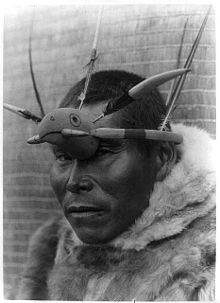
Back Аляскаялъул юпикал AV Alyaska yupikləri Azerbaijani Юпік Цэнтральнай Аляскі Byelorussian Pobo iupik de Alasca central Galician 中央ユピック Japanese Алясканал юпик LBE Аляска юпиквлӓ MRJ Юпики центральной Аляски Russian Средњоаљаски Јупици Serbian Yupikler Turkish
| Total population | |
|---|---|
| 34,000 (2010 U.S. Census) | |
| Regions with significant populations | |
| United States (Alaska) | 34,000 |
| Languages | |
| Yupʼik (and dialects: Cupʼik, Cupʼig), English | |
| Religion | |
| Christianity (Moravian Protestant, Catholic, Russian Orthodox) and Native | |
| Related ethnic groups | |
| Siberian Yupik, Sugpiaq/Alutiiq, Naukan, Iñupiat, Inuit, Aleut | |

The Yupʼik or Yupiaq (sg & pl) and Yupiit or Yupiat (pl), also Central Alaskan Yupʼik, Central Yupʼik, Alaskan Yupʼik (own name Yupʼik sg Yupiik dual Yupiit pl; Russian: Юпики центральной Аляски), are an Indigenous people of western and southwestern Alaska ranging from southern Norton Sound southwards along the coast of the Bering Sea on the Yukon-Kuskokwim Delta (including living on Nelson and Nunivak Islands) and along the northern coast of Bristol Bay as far east as Nushagak Bay and the northern Alaska Peninsula at Naknek River and Egegik Bay. They are also known as Cupʼik by the Chevak Cupʼik dialect-speaking people of Chevak and Cupʼig for the Nunivak Cupʼig dialect-speaking people of Nunivak Island.
The Yupiit are the most numerous of the various Alaska Native groups and speak the Central Alaskan Yupʼik language, a member of the Eskimo–Aleut family of languages. As of the 2010 U.S. Census, the Yupiit population in the United States numbered over 34,000 people, of whom over 22,000 lived in Alaska. The vast majority of these live in the seventy or so communities in the traditional Yupʼik territory of western and southwestern Alaska.[1] About 10,000 speak the language.[2] The Yupʼik had the greatest number of people who identified with one tribal grouping and no other race (29,000).[3] In that census, nearly half of American Indians and Alaska Natives identified as being of mixed race.
Yupʼik, Cupʼik, and Cupʼig speakers can converse without difficulty, and the regional population is often described using the larger term of Yupʼik. They are one of the four Yupik peoples of Alaska and Siberia, closely related to the Sugpiaq ~ Alutiiq (Pacific Yupik) of south-central Alaska, the Siberian Yupik of St. Lawrence Island and Russian Far East, and the Naukan of Russian Far East.
The Yupʼik combine a contemporary and a traditional subsistence lifestyle in a blend unique to the Southwest Alaska. Today, the Yupʼik generally work and live in western style but still hunt and fish in traditional subsistence ways and gather traditional foods. Most Yupʼik people still speak the native language and bilingual education has been in force since the 1970s.
The neighbours of the Yupʼik are the Iñupiaq to the north, Aleutized Alutiiq ~ Sugpiaq to the south, and Alaskan Athabaskans, such as Yupikized Holikachuk and Deg Hitʼan, non-Yupikized Koyukon and Denaʼina, to the east.[4]
- ^ U.S. Census Bureau. (2004-06-30). "Table 16. American Indian and Alaska Native Alone and Alone or in Combination Population by Tribe for Alaska: 2000". American Indian and Alaska Native Tribes for the United States, Regions, Divisions, and States (PHC-T-18). U.S. Census Bureau, Census 2000, special tabulation. Retrieved on 2007-04-12.
- ^ Alaska Native Language Center. (2001-12-07). "Central Alaskan Yupʼik." University of Alaska Fairbanks. Retrieved on 2014-04-04.
- ^ 2010 Census Shows Nearly Half of American Indians and Alaska Natives Report Multiple Races
- ^ "The Map of Indigenous Peoples and Languages of Alaska". Archived from the original on 2012-12-10. Retrieved 2014-11-29.
© MMXXIII Rich X Search. We shall prevail. All rights reserved. Rich X Search